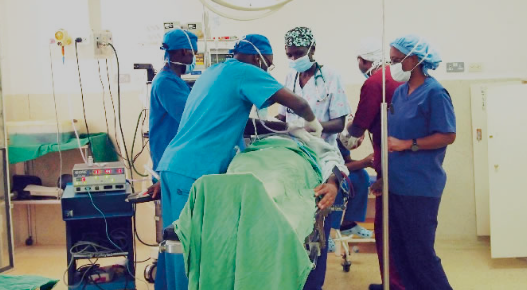
In the intricate dance of surgery, anesthesiologists play a crucial role as maestros, orchestrating the delicate balance between unconsciousness and vital stability. In Nigeria, a nation witnessing advancements in healthcare, the role of anesthesiologists is pivotal. This essay embarks on a comprehensive exploration of anesthesiologist roles in Nigeria, unraveling their responsibilities, educational journey, challenges, and the evolving landscape of this indispensable medical profession.
The Significance of Anesthesiologists
A. Ensuring Patient Comfort and Safety
- Administration of Anesthesia: Anesthesiologists administer various types of anesthesia, tailoring their approach to the patient’s needs and the nature of the medical procedure.
- Monitoring Vital Signs: Constant vigilance characterizes their work, with a focus on monitoring vital signs such as heart rate, blood pressure, and oxygen levels.
B. Facilitating Surgical Procedures
- Pain Management: Anesthesiologists play a pivotal role in managing pain, ensuring that patients remain comfortable during and after surgery.
- Collaboration with Surgical Teams: Effective collaboration with surgical teams ensures the seamless progression of medical procedures.
Educational Journey
A. Academic Foundation
- Medical Degree: Anesthesiologists begin their journey with a medical degree, undergoing the rigorous training typical of medical professionals.
- Internship and Residency: Post-medical school, they embark on internship and residency programs to gain hands-on experience in various medical specialties.
B. Specialization in Anesthesiology
- Anesthesiology Residency: Anesthesiologists undergo specialized residency training focused on anesthesia techniques, pain management, and critical care.
- Board Certification: Attaining board certification is a crucial step, demonstrating proficiency and adherence to the highest standards in the field.
Responsibilities and Challenges
A. Precision in Administration
- Dosage Calculation: Anesthesiologists must calculate and administer precise dosages of anesthesia, taking into account factors such as patient weight, age, and overall health.
- Adapting to Patient Variables: Individual patient responses to anesthesia can vary, requiring anesthesiologists to adapt their approach for optimal outcomes.
B. Crisis Management
- Emergency Situations: Anesthesiologists must be adept at managing emergencies, such as unexpected changes in a patient’s condition during surgery.
- Collaboration in Critical Care: Collaboration with critical care teams becomes crucial when patients require intensive postoperative care.
Technological Advancements in Anesthesiology
A. Monitoring and Equipment
- Advanced Monitoring Devices: Technological advancements have introduced sophisticated monitoring devices, enhancing the precision of vital sign tracking.
- Innovations in Anesthesia Machines: Modern anesthesia machines integrate advanced features for precise control over the delivery of anesthesia.
B. Telemedicine in Anesthesiology
- Remote Consultations: The integration of telemedicine allows anesthesiologists to provide consultations and preoperative assessments remotely.
- Enhancing Accessibility: Telemedicine initiatives contribute to improving accessibility to anesthesia expertise, particularly in remote or underserved areas.
Anesthesiologists in Nigeria: Current Landscape
A. Healthcare Institutions
- Hospitals and Surgical Centers: Anesthesiologists are integral to the functioning of hospitals and surgical centers across Nigeria.
- Rural Healthcare Initiatives: Efforts are being made to extend anesthesia services to rural areas, addressing disparities in healthcare access.
B. Demand for Anesthesiologists
- Growing Surgical Procedures: As the demand for surgical interventions increases, so does the need for skilled anesthesiologists.
- Maternal Healthcare: Anesthesiologists play a critical role in maternal healthcare, especially during cesarean sections and complicated deliveries.
Opportunities for Career Advancement
A. Subspecialties in Anesthesiology
- Critical Care Anesthesia: Anesthesiologists may specialize in critical care, providing expertise in intensive care unit (ICU) settings.
- Pain Management: The field of pain management offers opportunities for anesthesiologists to focus on alleviating chronic pain conditions.
B. Academic and Research Roles
- Teaching and Mentorship: Experienced anesthesiologists may engage in teaching and mentoring the next generation of medical professionals.
- Research Contributions: Participation in research contributes to advancements in anesthesia techniques and patient care.
Collaboration and Communication
A. Team Collaboration
- Surgical Teams: Effective collaboration with surgeons, nurses, and other healthcare professionals is essential for successful surgical outcomes.
- Communication with Patients: Anesthesiologists communicate with patients to alleviate concerns, explain procedures, and ensure informed consent.
B. Multidisciplinary Approach
- Collaboration with Specialists: Anesthesiologists work closely with specialists in various fields to address the unique needs of diverse patient populations.
- Preoperative Assessments: Thorough preoperative assessments involve collaboration with other healthcare professionals to ensure comprehensive patient care.
Government Regulations and Oversight
A. Medical Board and Certification
- Regulatory Compliance: Anesthesiologists adhere to regulations set by medical boards and certification bodies to maintain the highest standards of practice.
- Continued Medical Education (CME): Engaging in ongoing CME activities is essential for staying abreast of evolving medical practices and guidelines.
The Future of Anesthesiology in Nigeria
A. Technological Integration
- Advancements in Monitoring Technology: Continuous advancements in monitoring technology will enhance the precision of anesthesia administration.
- Robotics in Surgery: The integration of robotics in surgery may necessitate further adaptations in anesthesia techniques.
B. Addressing Healthcare Disparities
- Rural Outreach Programs: Initiatives aimed at extending anesthesia services to rural areas will contribute to addressing healthcare disparities.
- Training and Capacity Building: Investing in training programs and capacity building will bolster the number of skilled anesthesiologists in the country.
Conclusion
In the heartbeat of surgery, anesthesiologists stand as guardians of consciousness, ensuring a seamless journey into the realm of healing. In Nigeria, their roles are not only pivotal in the present but hold the promise of shaping a healthier future. As the nation advances in healthcare, anesthesiologists find themselves at the intersection of science, compassion, and technological progress.
The challenges of precision in administration and crisis management are met with resilience and a commitment to excellence. Technological innovations propel the field forward, opening new avenues for patient care and professional collaboration. In the heart of healthcare institutions and on the forefront of rural outreach, anesthesiologists in Nigeria navigate a dynamic landscape with dedication and expertise.
As Nigeria looks to the future, the role of anesthesiologists will continue to evolve, marked by advancements in technology, increased accessibility to healthcare, and a steadfast commitment to patient-centric care. In nurturing lives and shaping the trajectory of healthcare, anesthesiologists in Nigeria are not only medical professionals but also architects of a healthier, more vibrant nation.







